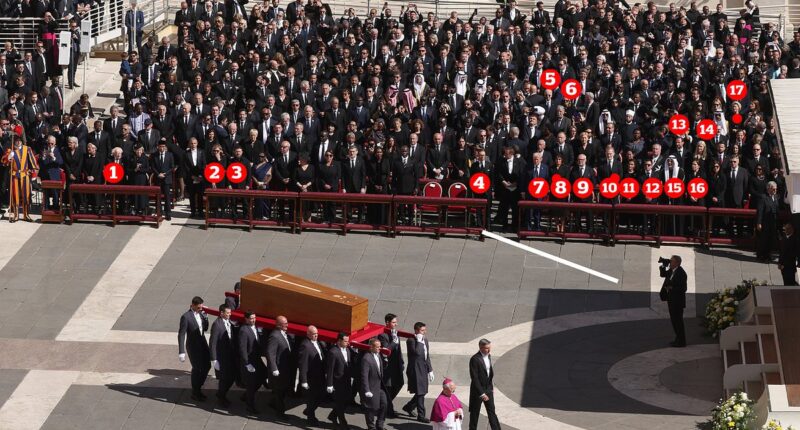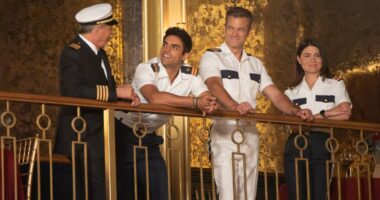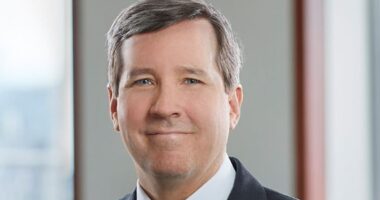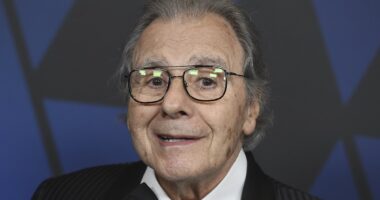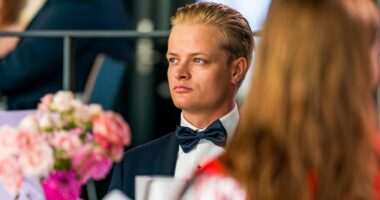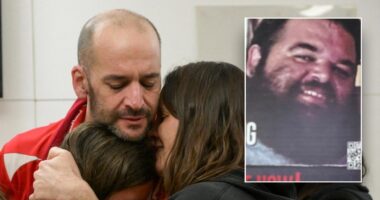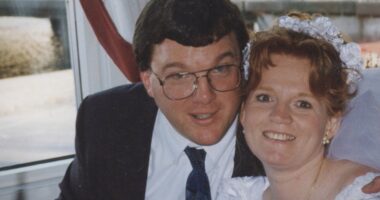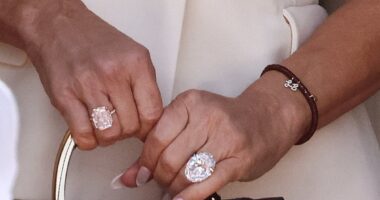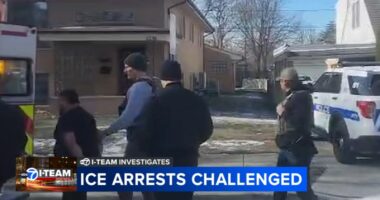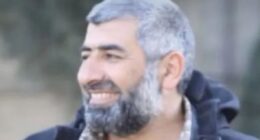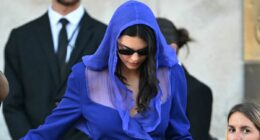When Pope Francis passed away, the world’s top leaders and dignitaries placed themselves in the hands of the Vatican’s funeral organizers.
Figures such as Volodymyr Zelensky, Donald Trump, Sir Keir Starmer, and Emmanuel Macron were strategically seated in what was called a ‘master plan’ to handle their prominent personalities.
There were rumors that Trump might be placed in the third row, a move he would have considered a slight. However, he was actually seated front and center during the service.
Alongside Trump and First Lady Melania, other front-row dignitaries include President of Ireland Michael D Higgins, Ukraine’s Volodymyr Zelensky – who made a last-minute trip to be there – and Argentina’s Javier Milei, given the top spot.
Milei found himself closest to the Pope’s humble wooden casket because Francis is of Argentine birth, born Jorge Mario Bergoglio in December 1936.
Next came Italy, as the Pope is also the bishop of Rome. Italian president Sergio Mattarella and his daughter Laura occupied the seats next to the Argentine leader. Immediately behind him sat Georgia Meloni, the Prime Minister of Italy.
Standing shoulder to shoulder with the Italian president Mr Mattarella, meanwhile, were the leaders of countries such as Albania and Angola.
However, Zelensky appears to have been given special treatment to ensure he was given a front row seat – as his place should have been further back.

1. Michael D Higgins, President of Ireland; 2. Olena Zelenska, First Lady of Ukraine; 3. Volodymyr Zelensky, President of Ukraine; 4. Alexander Stubb, President of Finland; 5. Joe Biden, former US President; 6. Jill Biden, former First Lady ; 7. Donald J Trump, US President; 8. Melania Trump, US First Lady; 9. Alar Karis, President of Estonia ; 10. King Felipe VI of Spain; 11. Queen Letizia of Spain; 12. Daniel Noboa, President of Ecuador; 13. Haakon, Crown Prince of Norway; 14. Mette-Marit, Crown Princess of Norway; 15. Mohammed bin Zayed Al Nahyan, President of the UAE; 16. Queen Mary of Denmark ; 17. Ursula von der Leyen, President of the European Commission

18. Albert II, Prince of Monaco; 19. Charlene, Princess of Monaco; 20. Sir Keir Starmer, UK Prime Minister (with his wife Victoria to the right); 21. Queen Mathilde of Belgium; 22. King Philippe of Belgium;

VIPs and dignitaries were arranged in the top corner of St Peter’s Square – across from cardinals and bishops, seen here in red
Prince William, on the other hand, found himself standing shoulder-to-shoulder with Olaf Scholz, the chancellor of Germany two rows behind Javier Milei and his sister Karina Milei, Argentina’s General Secretary of the Presidency.
William attended on behalf of his father of King Charles III, the United Kingdom’s head of state.
As for Sir Keir, he had to settle for a number of rows back alongside wife Victoria as a head of a government rather than the head of a state – as did the likes of Ursula von der Leyen, president of the European Commission.
The idea that the UK and other countries have been snubbed, or sent further down the pecking order, however, doesn’t quite ring true – as Vatican planners have tried to wield diplomacy in determining the pecking order.
The Vatican seating plan for dignitaries – who are sitting directly across from senior clergy – prioritises reigning monarchs and heads of state over heads of Government: presidents, kings and queens come before prime ministers.
But even then, there is an order beyond priority. Despite designating Latin and Italian as its official languages, the Vatican has arranged its seating plan in French alphabetical order.
This was chosen as, thanks to France’s historical power across the continent, it is still considered the language of European diplomacy.
So the United States becomes les États-Unis; Germany becomes Allemagne, pushing it towards the front of the queue; and the United Kingdom is shoved further back under Royaume-Uni.
This explains why Trump found himself front and centre among around 50 heads of state, and why heads of governments – like Sir Keir – found themselves further back in what may in other circumstances be considered the ‘cheap seats’.
Next to Milei, Joan-Enric Vives i Sicilia, a Catholic prelate and co-Prince of the tiny landlocked nation of Andorra, is standing shoulder to shoulder with Bajram Begaj, the president of Albania, and João Lourenço, president of Angola.
What it does not explain, however, is why President Zelensky found himself in the front row despite Ukraine remaining the same in French.
He and his wife were sandwiched somewhere between France and Ireland in what appeared to be a flouting of the rules.
Asked for comment by The Telegraph, the Vatican did not deny that this was the case.
Spokesperson Matteo Bruni said: ‘I believe they filled a vacant place.’
The late Pope’s position on Ukraine has been criticised prior to his death, as he had suggested the country take the ‘courage of the white flag’ and sue for peace with Russia, a standpoint rejected by Ukrainians. Francis had also stopped short of condemning Vladimir Putin as the aggressor in the conflict.
There was no special treatment for Britain, however. Sir Keir, Lady Victoria and Foreign Secretary David Lammy have found themselves squashed in between dignitaries from Qatar and Serbia.

1. Michael D Higgins, President of Ireland; 2. Olena Zelenska, First Lady of Ukraine; 3. Volodymyr Zelensky, President of Ukraine

4. Alexander Stubb, President of Finland; 5. Joe Biden, former US President; 6. Jill Biden, former First Lady ; 7. Donald J Trump, US President; 8. Melania Trump, US First Lady; 9. Alar Karis, President of Estonia ; 10. King Felipe VI of Spain; 11. Queen Letizia of Spain; 12. Daniel Noboa, President of Ecuador; 13. Haakon, Crown Prince of Norway; 14. Mette-Marit, Crown Princess of Norway; 15. Mohammed bin Zayed Al Nahyan, President of the UAE; 16. Queen Mary of Denmark ; 17. Ursula von der Leyen, President of the European Commission

18. Albert II, Prince of Monaco; 19. Charlene, Princess of Monaco; 20. Sir Keir Starmer, UK Prime Minister (with his wife Victoria to the right); 21. Queen Mathilde of Belgium; 22. King Philippe of Belgium;

23. João Lourenço, President of Angola; 24. Bajram Begaj, President of Albania; 25. Sergio Mattarella, President of Italy; 26. Prince William; 27. Javier Milei, President of Argentina; 28. Olaf Scholz, Chancellor of Germany; 29. Giorgia Meloni, Prime Minister of Italy

The seating arrangements for the Pope’s funeral were an exercise in diplomacy – with heads of state given priority, and their order decided purely by the alphabet, albeit in French (pictured: world leaders during the funeral)

Argentina’s Javier Milei (bottom right, next to a Swiss Guard) was given the first seat of the front row, closest to the coffin, because of the Pope’s Argentine roots. He stood next to his sister, followed by Italy’s President Sergio Mattarella

The Pope’s funeral has been an exercise in diplomacy, in more ways than one (pictured: Emmanuel Macron is seen putting his arm on the shoulder of Ukrainian president Volodymyr Zelensky in St Peter’s Square)

Volodymyr Zelensky and his wife Olena Zelenska sit in the front row of dignitaries at the Pope’s funeral

Donald Trump and his wife Melania found themselves front and centre – next to the president of Estonia Alar Karis and Spain’s King Felipe. Poland president Andrzej Duda can be seen in the top left, next to his wife Agata, beside Philippines president Ferdinand ‘Bongbong’ Marcos Jr and his wife Louise

(L/R)The daughter of Italy’s President Laura Mattarella, Italy’s President Sergio Mattarella, General Secretary of the Presidency of Argentina, Karina Milei and Argentina’s President Javier Milei look on during late Pope Francis’ funeral ceremony at St Peter’s Square at the Vatican on April 26, 2025. (Photo by Filippo MONTEFORTE / AFP) (Photo by FILIPPO MONTEFORTE/AFP via Getty Images)

Prince William – pictured leafing through the 88-page order of service for the Pope’s funeral – found himself sitting alongside German Chancellor Olaf Scholz

Keir Starmer and his wife Victoria (circled) had to settle for several rows back because of the Vatican’s decision to put heads of state in front of heads of government

Donald Trump and Volodymyr Zelensky met face-to-face before the funeral – two months after their hot-headed face-off at the White House
Cardinal Vincent Nichols, the leader of Catholics in England and Wales, said the funeral organisers are well-used to dealing with the sensitivities of such big events.
In an interview with the PA news agency in Rome prior to the funeral, he said the funeral will be ‘without a doubt another masterpiece of stage management when you consider those state leaders who have high opinions of their importance’.
He added: ‘In the past, I’ve seen it here over and over again that the combination of Rome and the Holy See, they actually are geniuses at dealing with these big events.
‘I think they’ve been doing it since the emperors ruled Rome – that they know how to deal with big egos.
‘And I think every leader of a nation that comes here on Saturday will go home reasonably content.’
Cardinal Nichols will take part in his first conclave to elect a new pope in the coming weeks. Today is the first of nine days of mourning, which must pass before any talk of a new pontiff can begin.
Other VIPs who wished to attend were found space, such as ex-US President – and lifelong Catholic – Joe Biden, who arrived with wife Jill. They were sat around five rows behind Donald Trump and his wife Melania.
Vatican spokesman Matteo Bruni said on Friday that no distinction was made between Catholic and non-Catholic royalty for the seating order.
The gathering of world leaders has already prompted rumblings of further diplomacy beyond that conducted by Vatican seat planners this week.
Donald Trump and Volodymyr Zelensky sat down and conversed before the funeral – with images showing them deep in conversation in an almost literal tête-à-tête.
Further talks are thought to be in the works after the pair’s hot-headed White House spat in February – as the pair try to hammer out a deal to bring an end to Russia’s three-year invasion of Ukraine.
The pair were also seen chatting with Emmanuel Macron and Keir Starmer.

Members of the clergy gather ahead of the funeral Mass of Pope Francis, in Saint Peter’s Square, at the Vatican, April 26, 2025 – watched over by a statue of St Peter

A sea of clergy at Pope Francis’ funeral mass in the Vatican. Around 250,000 people were packed into and around St Peter’s Square before officials sealed the entrances

Britain’s Prince William arrives ahead of the late Pope Francis’ funeral ceremony on April 26

Donald Trump (back) waves as he leaves with US First Lady Melania Trump after attending Pope Francis’ funeral ceremony, in Rome on April 26, 2025

Thousands of people line the streets as the coffin is transferred to the Papal Basilica

A popemobile converted into a hearse transfers the coffin of Pope Francis to the Papal Basilica of Saint Mary Major
Hundreds of thousands of people packed out St Peter’s Square and the streets of Rome for Francis’ open-air service, which saw a requiem mass held in Vatican City before the late pontiff’s coffin was driven across the Italian capital to its final resting place.
Francis, hailed as the ‘people’s pope’ due to his focus on society’s neediest, died aged 88 on Monday just hours after greeting crowds to mark Easter.
He lay in state in St Peter’s Basilica for three days, with some 250,000 mourners passing him day and night, before his coffin was formally sealed in private on Friday, with his face covered by a simple white shroud.
Francis was ‘a pope among the people, with an open heart’, who strove for a more compassionate, open-minded Catholic Church, Cardinal Giovanni Battista Re said in his funeral homily.
There was applause as he hailed the pope’s ‘conviction that the Church is a home for all, a home with its doors always open’.
It was ultimately prisoners and migrants who ushered the pope into the St. Mary Major Basilica where he is set to be buried, reflecting his priorities as head of the Catholic Church.
It is the first time in more than 100 years that a Pope has not been buried at the Vatican – but it was not the Pope’s only break with convention.
His casket was a simple wooden casket, lined with zinc and emblazoned with a cross, a far cry from the traditional combination of three coffins made of cypress wood, lead and oak.
His tomb will be similarly humble: an alcove in the church that was previously used to store candlesticks. It will be labelled with just his papal name in Latin: Franciscus.

Pope Francis died on Monday aged 88, hours after greeting the faithful to mark Easter Sunday (pictured)

The Pope’s coffin is driven past the Colosseum en route to the Santa Maria Maggiore church as people film it on their phones

The requiem mass lasted almost two hours, and saw prayers read in several languages to the audience of thousands from around the world

The coffin is led away following the service – watched by world leaders, some of whom applauded as others chose to film it on their mobiles

The coffin of Pope Francis arrives at St. Mary Major Basilica (Santa Maria Maggiore) following the service

Pope Francis came to the church to pray more than 100 times, typically before or after an overseas journey (seen here in a picture released by the Vatican March 12)

The pope will be interred here, as per his wishes, with a simple inscription bearing his papal name in Latin, Franciscus

Hundreds of thousands of people packed out St Peter’s Square – with thousands more lining the streets of Rome

The rite of the Velatio before to seal the coffin of Pope Francis on the eve of his funeral at The Vatican

Italian cardinal Giovanni Battista Re (left, praying) officiates near the coffin of late Pope Francis during the funeral ceremony at St Peter’s Square

The Pope’s coffin is conveyed through the streets of Rome following the requiem mass in Vatican City. Around 150,000 lined the streets, according to the Vatican

The popemobile – a converted Dodge RAM pick-up truck – was adapted to ensure the coffin could be carried safely while allowing mourners to see it clearly

Grief-stricken faithful react as the funeral of Pope Francis takes place in St Peter’s Square

Mourners react as Pope Francis’ coffin passes by in the streets of central Rome on the four mile journey to the church where he will be buried

A group of nuns is seen standing in the streets of Rome before sunrise on Saturday morning

People on Via della Conciliazione – the long thoroughfare in Rome that leads to the Vatican – ahead of the service
Pope Francis died on Monday, aged 88, from a stroke and irreversible heart failure in his beloved Casa Santa Marta residence.
In his final hours, he had joined crowds for an Easter Sunday blessing at St Peter’s Square. The pontiff had only recently been discharged from hospital, after five weeks of treatment for an infection that led to double pneumonia.
Ahead of the funeral, thousands of people made their way along Via della Conciliazione – the grand thoroughfare that leads to the Vatican – singing hymns, praying and swapping stories.
Some camped out in the streets in sleeping bags and foil blankets to ensure they secured their spot in St Peter’s Square. Vatican officials sealed the entrances when capacity was hit – and later said around 250,000 people were present in and around the square.
‘I’m touched by how many people are here. It’s beautiful to see all these nationalities together,’ said Jeremie Metais, 29, from Grenoble, France, ahead of the ceremony.
‘It’s a bit like the centre of the world today.’
‘We want to say goodbye because he (was a) living saint, very humble and simple,’ said Mary James, a Franciscan nun, who had stayed up overnight to guarantee a good place.
‘You can feel a lot of energy, yes, a little bit of despair because we are tired, but ultimately we want to come and say ‘thank you’, thanks to Pope Francis for all he did for his church,’ said Eduardo Valencia, visiting from Mexico.
The massive crowd was largely silent, watching proceedings on several large screens around the square.
Applause then rang out at the start of the ceremony as 14 white-gloved pallbearers carried the coffin, inlaid with a large cross, out of St. Peter’s Basilica and into the square.
The pope’s casket was placed on a carpet in front of the altar, with the book of gospels laid on top, as the Vatican choirs sang.

Attendees in St Peter’s Square receive communion wafers during the service for Pope Francis

Pope Francis’ coffin – a humble wooden casket lined with zinc – is taken back inside St Peter’s Basilica following his requiem Mass

Huge crowds gathered in the centre of Rome to bid farewell to Pope Francis after his death at the age of 88
Choirs sang Latin hymns and prayers were recited in various languages, including Italian, Spanish, Chinese, Portuguese and Arabic, reflecting the global reach of the 1.4-billion-member Roman Catholic Church.
The crowd broke into applause when Italian Cardinal Giovanni Battista Re spoke of Francis’ care for immigrants, his constant pleas for peace, the need for negotiations to end wars and the importance of the climate.
‘Rich in human warmth and deeply sensitive to today’s challenges, Pope Francis truly shared the anxieties, sufferings and hopes of this time,’ Re said.
‘Pope Francis incessantly raised his voice imploring peace and calling for reason and honest negotiation to find possible solutions.
‘War, he said, results in the death of people and the destruction of homes, hospitals and schools. War always leaves the world worse than it was before: it is always a painful and tragic defeat for everyone.
”Build bridges, not walls’ was an exhortation he repeated many times.’
Speaking to the Pope’s ability to connect with people, Cardinal Battista Re added: ‘He had great spontaneity and an informal way of addressing everyone, even those far from the Church.
‘Rich in human warmth and deeply sensitive to today’s challenges, Pope Francis truly shared the anxieties, sufferings and hopes of this time.
‘He gave of himself by comforting and encouraging us with a message capable of reaching people’s hearts in a direct and immediate way.’
He recalled how the Pope, in what would become his final public act, insisted on blessing the crowds on Easter Sunday despite his ailing healh.
‘The final image we have of him, which will remain etched in our memory, is that of last Sunday, Easter Sunday, when Pope Francis, despite his serious health problems, wanted to give us his blessing from the balcony of St Peter’s Basilica,’ the Cardinal said.
Crowds at the funeral applauded as the pontiff’s coffin both emerged from and then was brought back into the basilica after the open-air mass.
Some of those who travelled from the UK and Ireland told of the importance of being present in-person to celebrate Francis’s life and reign as pope.
Phil Callaghan, from Manchester, said he booked flights as soon as the Pope died, describing the crowds gathered in the city as ‘astounding’ and that ‘it’s shown just how much Pope Francis meant to people’.
Speaking to the PA news agency in Rome, friend and fellow Mancunian Kate Wilkinson said it had been ‘an incredible opportunity to witness history’, describing it as ‘the most amazing moment of my life’.
